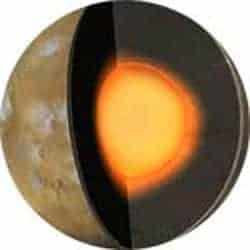Physicists at the Jet Propulsion Laboratory (JPL) in the US have found that the core of Mars could be soft and liquid-like. This result, which is based on the analysis of over three years of data from the Mars Global Surveyor (MSG), is at odds with previous findings that indicated a solidified Martian core (C F Yoder et al. 2003 Sciencexpress to be published).

Previous analyses of meteorites have shown that the Martian crust is magnetic. This information, together with measurements of the moment of inertia, implies that the Red Planet has a large iron core that was liquid in the past.
William Folkner and co-workers at JPL studied a phenomenon called “solid-body tides” that are caused by the pull of the Sun’s gravitational field on Mars. These tides also cause the orbit of the MGS around Mars to be altered slightly. By measuring the extent of this displacement, the researchers are able to calculate the value of a quantity known as the “tidal Love number”, k2 . A large k2 indicates that Mars is being deformed more strongly, which means that it must be less rigid, and a small k2 points towards a more solid planet.
The researchers found a k2 of around 0.15, which is about twice as large as previous estimates. This result implies a liquid centre – at least for the outer part of the core. Values of less than around 0.1 indicate that the core is solid.
The team now hopes to further refine its study by using new data from the MGS together with information from the Odyssey spacecraft, which is also in orbit around Mars. “In addition, the Mars Reconnaissance Orbiter – to be launched in 2005 – also provides an excellent opportunity to improve our results,” Alex Konopliv, a member of the group, told Physics Web.



